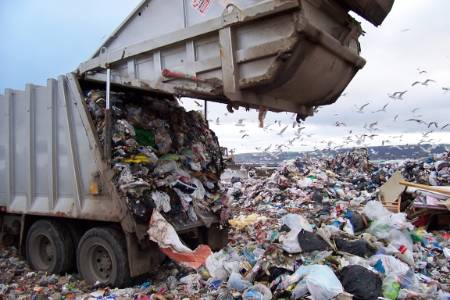 Remember those old, clunky TVs and computer monitors? The ones with Cathode Ray Tubes (CRTs) people threw out in favor of flat screens? Well, now electronics makers don't want to recycle them.
Remember those old, clunky TVs and computer monitors? The ones with Cathode Ray Tubes (CRTs) people threw out in favor of flat screens? Well, now electronics makers don't want to recycle them.
Up until this week, California state law directed certified waste recyclers to sell leaded Cathode Ray Tube (CRT) glass from the old clunkers back to CRT makers or smelters.
But now we’re down to just one CRT maker and it’s in India. Neuro-toxic leaded glass started piling up in warehouses or got illegally dumped. So, the Department of Toxic Substances Control (DTSC) just issued an “emergency rule." Recyclers can go ahead and just take CRT glass to hazardous waste landfills located in some of the poorest, largely Latino, communities in the state.
Consumers buying TVs pay between six and ten dollars at the point of sale to fund a state program that pays recyclers to recycle. Now, we’ll be paying recyclers to dump more toxins into poor neighborhoods already suffering from high rates of pollution.
Granted, the DTSC had to do something. But this was not the right something. Exceptions to rules tend to become permanent. And can be abused. This rule should be immediately reversed. Recyclers are already paid to recycle. They can use some of that money to pay a little more for CRT processing. Eventually, the technology will take off and the price will come down. That’s how markets work.
Under California law, regulators are supposed to encourage new hazardous waste treatment technologies that reduce or eliminate the hazards to human health and the environment, where they can be practically utilized, to improve California’s economic and environmental well-being.
What the DTSC just did was the reverse. “This is knocking the legs out from under the industry that is developing the recycling technologies and making the capital investment,” said Jim Taggart, head of ECS Refining, the second-largest recycler in the country based in Stockton. The state should simply have kept its rules in place, he said. “It’s done by just not encouraging landfill. You require recycling and the system takes care of it.”
ECS Refining is concentrating lead from CRT glass and selling it back to smelters. We need lead for new batteries. It’s selling glass to new customers from insulation to cement makers in other states. And the new technology can be adapted later to other materials as electronics advance.
The impetus for the emergency rule had to come from somewhere, said Taggart. “Possibly the waste industry or recyclers that stand to benefit from landfilling the glass.” Taggart says that unscrupulous recyclers could end up putting leaded glass in ordinary, unlined municipal landfills that charge much less to take waste. And waste management companies that own landfills stand to profit from the boom in business.
“We invested $10 million dollars into this technology,” he said. “What’s a hammer cost?” He said unscrupulous recyclers will just break up CRTs by hand, and throw what they think is harmless glass into cheap municipal landfills. But he says that glass will still contain toxic levels of lead that can leach into the environment. “The state won’t have any way to control that. It doesn’t have people at every landfill.”
Instead, regulators should be huddling with California lawmakers to see what can be done to use a chunk of that steady stream of money from consumers for electronics recycling to encourage the new technology. And it doesn’t have to stop there. Sheila Davis, executive director of the Silicon Valley Toxics Coalition says we need a paradigm shift. “We think the HPs, Apples, and Dells should be paying to make sure this stuff is not dumped on poor people but taken back and recycled responsibly.”
California might just want to join the 21st century and pass, like 23 other states have done, an Extended Producer Responsibility Law that makes electronics manufacturers that design, produce or sell a product minimize its environmental impact throughout its life cycle.
We’d shift away from charging consumers a recycling fee and have the manufacturer build the cost into product for its dismantling and recycling. That would be quite an incentive to figure out how to make products that are less toxic and easier to dispose of in the first place.
Instead, this DTSC is helping to sully the present and landfill the future.






